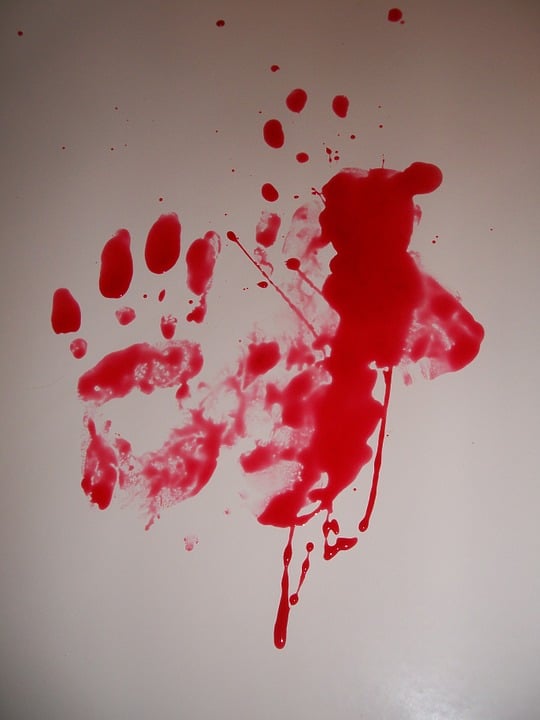It’s a fact of life that, no matter how careful you’re being, you are going to encounter blood at some point or another. Whether you get a paper cut on the electric bill or you have an accident with the table saw that results in a large pool of blood, you or your family will have to figure out how to clean up the after effects.
As a general rule of thumb (hopefully one that’s still attached after using the table saw), if the pool of blood is smaller than a dinner plate, you can clean and sanitize it yourself. If it’s much larger than that, you should contact a biohazard remediation company to clean everything up for you. They will have the appropriate know-how, tools, chemicals, and method of transporting biohazardous waste to ensure that the job is done thoroughly and safely.
For the purpose of this article, however, we are going to assume that the collection of blood is smaller than a dinner plate, so you can safely clean and sanitize it by yourself.
What is the difference between cleaning and sanitizing?
Though often used synonymously, cleaning and sanitizing where blood is concerned are two entirely different things. Cleaning just means that you have made it so that your naked eye can’t see any red or rust-colored stains anymore. It usually means that you have wiped up the spill with a rag, cleaning product, and maybe even a little bleach so that you can’t see it anymore.
The problem with blood and other biohazardous materials is that they tend to seep into things. Even when left for just a small amount of time, blood can penetrate wood, carpeting, linoleum, and painted walls. By wiping the blood up with a rag, you might not see it anymore, but the potentially dangerous bacteria and viruses that sometimes accompany blood products may still be lurking there.
Sanitizing, on the other hand, means going down deeper than the surface. It’s more than spraying multi-purpose cleaner on a blood-spattered surface and leaving it there to soak. When you’re shopping for a sanitizer, make sure that it is a broad-spectrum sanitizer that will kill bacteria and germs associated with blood and other organic matter. These chemicals will penetrate deeper into the covered material to remove all of the potentially harmful things that blood can spread.
Keep in mind that materials such as carpet and upholstery tend to hold on to bloodborne pathogens more forcefully and also resist cleaning and sanitization processes without damage. Your best option in this circumstance is to get rid of the furniture or carpet completely.
What equipment do I need?
When you’re facing the task of cleaning up a bloodstain, you will need some equipment in order to do it safely. Some people feel that cleaning up your own blood or that of someone you know well means that you don’t need to use personal protective equipment (PPE) or follow correct procedures, but that is absolutely false! You need to be as careful with your own blood (or the blood of a friend) as with that of a stranger on the street.
Regardless of whose blood it is, you will need the following PPE:
- Gloves
- Mask
- Eye protection
- Protective clothing
Additionally, you will need:
- Broad spectrum disinfectant
- Paper towels
- Biohazard disposal bags/sharps containers
- Tongs or dustpan
What procedure should I follow?
- Start by donning your PPE and assessing the situation. If there is any broken glass or equipment in the area, use the tongs or dustpan to remove it, making sure not to touch anything with your hands.
- Soak up the blood using paper towels or disposable cloths. Wipe up all spilled blood, and throw towels away in a biohazard bag.
- Pour your broad spectrum disinfectant on the affected area and let it sit for 10-15 minutes. Wipe up the disinfectant with more disposable towels and then throw them in the biohazard bag.
- Repeat step three again, and then wipe down the area with disinfectant-soaked towels and let the area dry.
- Clean any equipment that you can reuse by following steps 3-4.
- Remove your PPE and throw it into the biohazard bag as well. Make sure to communicate with your health department as to their standard protocol for disposing of biohazardous waste.
- Inspect your body to make sure that you haven’t been contaminated and then wash yourself thoroughly with soap and hot water. If you have been contaminated, go to the doctor or hospital to have yourself tested for bloodborne pathogens.
It is crucial to your and your family’s future safety and health to take extra precautions when cleaning up and sanitizing areas that have come in contact with blood. If you have questions or are concerned about your ability to clean up properly, contact your local disaster cleanup specialists about professional biohazard remediation.

